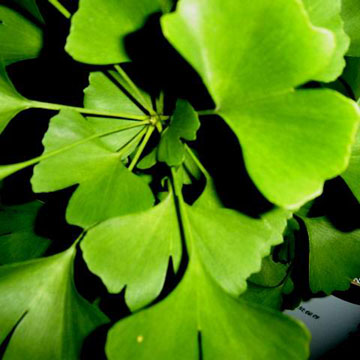Ginkgo

Ginkgo is a member of the gymnosperms, plants with seeds that are exposed, rather than enclosed in fruits as in the angiosperms. The species is the sole survivor of a group of trees, which, in early geological times, was almost cosmopolitan. Direct ancestors of the tree existed in many parts of the world before the beginning of the Jurassic period (about 180 million years ago). It has sometimes been described as a “living fossil”.
Probably the species no longer exists in the truly wild state. It is a scared tree in the Far East, being commonly planted in the grounds of temples and palaces; some specimens are reputed to be over 100 years old. Because of the present day interest in ginkgo as a herbal product and for urban planting, it is now cultivated in large-scale plantations in China, France, and North Carolina and Maryland in the USA, and no doubt other places. The trees are good for urban planting because they can withstand high levels of pollution and low elves of sunlight.
Ginkgo is a deciduous tree up to 35 m (120 ft) in height and 1 m (3 ft) in trunk diameter. The stalked leaves have fan-shaped blades 5-7cm (3 in) across, with an apical notch. They superficially resemble the leaves of the maidenhair fern. The male and female flowers are borne on separate trees, and the seed (often erroneously referred to as a fruit) is about 3 cm (1 in) across and with a fleshy covering. A disadvantage with ginkgo as an urban tree is that the female produces seed, which gives off an unpleasant smell when it drops.
The kernels of the seed are edible, with about 10% protein, 2.5% fat, and 67% starch. In China and Japan they are often eaten roasted at weddings and fests, and are supposed to aid digestion and diminish the effects of drinking too much wine. On the other hand, contact or ingestion of the fleshy covering of the seed may lead to severe allergic reactions, including blisters. It is reported that the seed contains a toxic substance that is responsible for “gin-nan” food poisoning in China and Japan. However, as stated earlier, the roasted kernel is quite a popular food item in the Orient; toxicity of the seed is related to excess taken during food shortages.
Gingko (both leaves and seeds), the leaf extract has become a best-selling herbal product in Western countries, with claims that it helps blood circulation (especially to the brain) and asthma. Improvement of blood circulation to the brain might alleviate the problem of diminishing mental and physical health with the onset of old age, by slowing down brain deterioration and offering some protection against strokes, memory loss, and tinnitus.
The key chemical constituents are flavonoids (flavonol glycosides and biflavones), diterpenes (ginkgolides), and sesquiterpenes (bilobalides).
Over the past 30 years a large number of clinical and scientific trials on humans and animals have been carried out, and they are continuing. In many cases, ginkgo extracts standardized to 24% flavonoid glycosides and 6% terpenoids have been utilize – other substances, e.g. ginkgolic acids, have been reduced to minute amounts. These acids are potent contact allergens, and this illustrates the necessity of standardizing herbal extracts. In Germany three different ginkgo extracts are reported, but only one is supported.
Some experiments support the claim that leaf extracts increase the blood flow to the brain (and the limbs) and scavenge free radicals that could affect brain cells. A great deal of attention has been paid to the action of the lead extract, which has been demonstrated to be a potent antagonist to the platelet activating factor. This action could also inhibit brain cell deterioration and, in addition, be useful in the treatment of asthma and inflammation.
There is much confidence as regards the value of ginkgo in the treatment of some aspects of geriatric illness; indeed, an enormous number of prescriptions for the drug are given by physicians in Germany.

